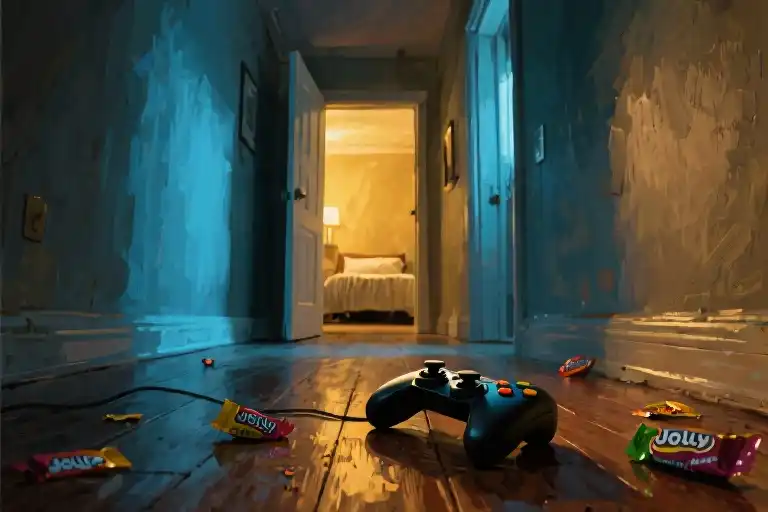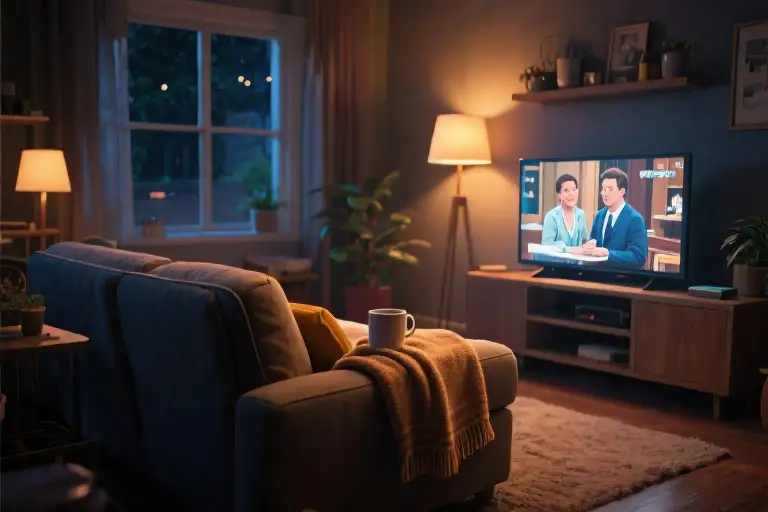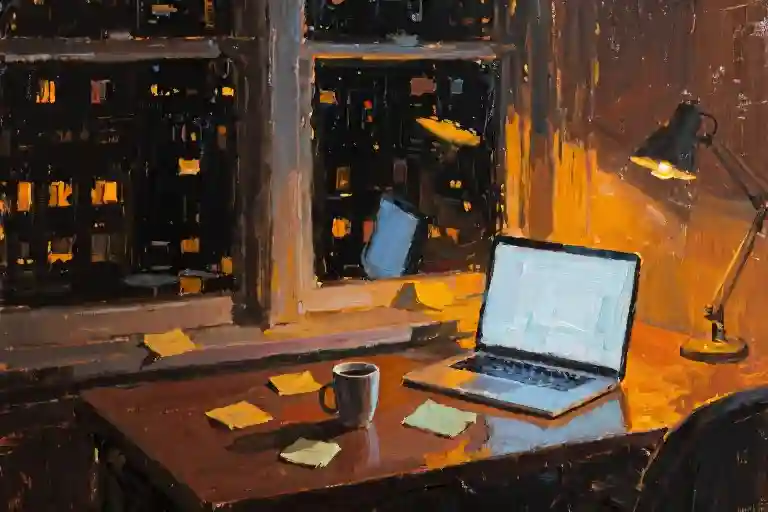The sound was barely noticeable at first – a faint cough from my daughter’s room, or maybe just her clearing her throat. I paused my video game, thumb hovering over the controller. Could’ve been nothing. Probably was nothing.
But my brain had already switched channels. She’d been eating Jolly Ranchers earlier. What if a piece got stuck? Would she call for help or try to handle it herself? At twelve, she’s at that awkward age where asking for assistance feels like admitting defeat. The seconds stretched as I imagined worst-case scenarios unfolding behind her closed door.
Anxiety works like bad Wi-Fi – it buffers the worst possible version of events before the actual content loads. By the time I’d abandoned my game to check, I’d mentally rehearsed the Heimlich maneuver three times.
Of course, she was fine. Sitting cross-legged on her bed, watching some makeup tutorial, candy wrapper crinkling in her hand. ‘What?’ she asked, pulling out one earbud when she noticed me lingering in the doorway. Nothing, I said. Just checking.
This happens more often than I’d care to admit. Not just with my daughter, but with my aging parents when they don’t answer calls promptly, or my husband when he’s late coming home from work. My brain treats ordinary life like an episode of some medical drama, constantly scanning for potential catastrophes in mundane moments.
What fascinates me isn’t the anxiety itself – we all have those flashes of irrational worry – but how quickly and completely it can rewrite reality. In the span of a few heartbeats, a normal afternoon becomes an emergency. The mind’s ability to construct elaborate disaster scenarios from the flimsiest raw materials would be impressive if it weren’t so exhausting.
Modern parenting seems specially designed to feed this tendency. We’re bombarded with warnings about choking hazards and online predators, school shooting drills and allergy alerts. No wonder our threat detectors malfunction. The world keeps handing us legitimate reasons to worry, and our neural pathways oblige by finding new things to panic about.
Yet here’s the paradox: these mental fire drills never actually prepare us for real emergencies. When my daughter actually did choke on a grape last year (properly, ambulance-and-all), my reaction bore no resemblance to these imagined scenarios. The real thing was quieter, sharper, and strangely calm. Anxiety’s rehearsals are like trying to learn swimming by practicing on dry land – all the flailing without any of the actual buoyancy.
Maybe that’s why we keep doing it. Not because it helps, but because it feels like doing something. In a world where we can’t control outcomes, at least we can control how many times we check.
When Anxiety Hijacks Your Day
The sound was barely noticeable at first—just a faint cough from my daughter’s room. Or maybe she cleared her throat. I kept my eyes on the video game, thumbs moving automatically. Could’ve been nothing. Probably was nothing.
Then the mental dominoes started falling. She’d been eating Jolly Ranchers earlier. Hard candy. Choking hazard. Would I hear real choking over the game audio? Would she come get me, or would my independent eleven-year-old try to handle it alone? My character died on screen as I imagined her turning blue, small hands clutching at her throat.
That’s when the what-ifs arrived like uninvited guests:
What if she’s too embarrassed to call for help?
What if I wait too long?
What if this is the moment I’ll replay forever in therapy sessions?
Game controller hit the couch before I’d consciously decided to move. When I opened her door—heart thumping like I’d run upstairs—she sat cross-legged on her bed watching makeup tutorials, candy wrapper in hand. “You okay?” I asked, trying to sound casual. She gave me that preteen look that translates to Why are adults so weird?
This wasn’t my first unnecessary panic rodeo. Last Tuesday, my mom missed our 3pm check-in call. By 3:07pm, I’d mentally planned her funeral (open casket vs. cremation debate included). Turns out her book club ran late. Then there’s my husband’s commute—every traffic delay becomes a multi-vehicle pileup in my imagination until his keys jingle in the door.
These mental hijackings share the same blueprint:
- Ambiguous Trigger: A neutral event (cough, missed call, late arrival)
- Instant Worst-Case Assignment: My brain skips “maybe” and goes straight to “definitely catastrophic”
- Physical Reaction: Pounding heart, tunnel vision, urgency to act
- Reality Check: The anticlimactic truth (YouTube, book club, traffic)
What fascinates me isn’t the anxiety itself, but how efficiently it bypasses logic. I don’t think Hmm, statistically, a Jolly Rancher choking is unlikely given she’s eaten hundreds safely. Anxiety whispers But what about THIS one? with the conviction of a weatherman predicting a hurricane in your living room.
You’d think after dozens of false alarms, my system would adjust. Yet here’s the humbling truth: next time I hear that cough, I’ll still pause the game. Not because I believe disaster struck, but because anxiety trades in possibilities, not probabilities. And the cost of checking—a few seconds of awkwardness—feels cheaper than the alternative, however improbable.
Maybe you know this dance too. That moment when:
- Your phone pings with a school notification and your stomach drops before reading
- Your partner sighs differently and you mentally draft breakup speeches
- A headache becomes brain tumor Google searches at 2am
These mental overreactions aren’t flaws—they’re the price of caring deeply in an uncertain world. The same wiring that makes me imagine candy-related tragedies also had me installing outlet covers when she was a toddler and checking her temperature every hour during her first fever. Anxiety might be an overzealous bodyguard, but it shows up for duty every time.
So I’m learning to thank it—”Appreciate the alert, but we’re good here”—before fact-checking its dramatic reports. Some days that works better than others. And when I inevitably peek into her room after some innocuous noise? Well, at least she’ll never doubt she’s loved. Even if that love sometimes looks like a parent barging in demanding “Are you dying?!” over a swallowed gum incident.
How Anxiety Rewrites Reality
The cough came from my daughter’s room just as I was about to beat the final boss. A small sound, really. The kind you’d normally ignore. But anxiety doesn’t do normal. In the space between game controller buttons, my brain had already written the full screenplay: Jolly Rancher lodged in throat → failed Heimlich maneuver → ambulance siren crescendo. All before I could even unpause the game.
This is what psychologists call ‘amygdala hijack’ – when your brain’s alarm system overrides rational thought. The primitive part of your mind that kept cavemen alive now makes modern parents sprint upstairs because a fourteen-year-old might be… eating candy while watching makeup tutorials. The absurdity isn’t lost on me even as I’m doing it.
The Three Tricks of Catastrophic Thinking
- Magnification: That tiny cough becomes a life-or-death situation. Anxiety operates like bad audio editing – it turns up the volume on potential threats while muting all evidence of normalcy.
- Acceleration: Thoughts move from ‘maybe’ to ‘definitely’ without stopping at intermediate stations. There’s no ‘perhaps she’s clearing her throat’ – we go straight to performing imaginary CPR.
- Absolutism: The imagined outcome has no escape clauses. In anxiety’s version of events, no one ever coughs and survives without parental intervention.
Anxiety as Screenwriter
Our worried minds don’t just predict disaster – they produce full sensory experiences. You don’t just think ‘car accident’, you hear the screeching tires, smell the burning rubber, feel the hospital bracelet on your wrist. This mental movie-making explains why we’ll abandon dinner to call someone who’s five minutes late – we’ve already watched their entire tragedy unfold in Dolby Digital.
What makes these scripts so convincing is their attention to detail. When my mother didn’t answer her phone yesterday, I didn’t just imagine ‘she might be hurt’ – I saw the exact way she’d fallen in her kitchen, which tile her head would hit, even the pattern on the paramedics’ uniforms. Anxiety doesn’t do rough drafts.
The cruel irony? This mental machinery evolved to protect us. That same rapid-response system that makes me check on my daughter would’ve saved ancestors from saber-toothed tigers. But in a world where actual threats are rare, the system misfires constantly – like a smoke detector triggered by toast.
Here’s what neuroscience tells us: the amygdala reacts in 50 milliseconds. The rational prefrontal cortex needs a full 500 milliseconds to weigh in. That 450-millisecond gap is where all our unnecessary panic lives. In that brief window, anxiety doesn’t just suggest worst-case scenarios – it makes them feel inevitable.
Recognizing these patterns won’t stop the initial alarm. But it helps create what therapists call the ‘observing self’ – the part of you that can notice the anxiety screenplay without being cast in it. When I stood in my daughter’s doorway holding a paused game controller, that small observing part whispered: ‘You’re doing the thing again.’ It didn’t stop me from checking, but it kept me from asking if she needed abdominal thrusts.
Next time your brain hands you one of these scripts, look for the production flaws. Is there really no second act where everything turns out fine? Why does this director only shoot horror films? The more you notice anxiety’s favorite tropes, the less convincing its productions become.
You’re Not Alone in This
The moment I paused my game to check on my daughter—only to find her perfectly fine with Jolly Ranchers and YouTube—I felt equal parts relief and embarrassment. Relief that she was safe, embarrassment at my own overreaction. Later that night, scrolling through parenting forums, I discovered something surprising: my ‘irrational’ panic was almost universal.
Research from the Child Mind Institute shows 85% of parents experience these sudden fear spirals. That statistic stuck with me—not because it justified my anxiety, but because it revealed how our brains share this peculiar glitch. We’re all running the same outdated survival software in modern parenting conditions.
Social media tells the same story. The #JustChecking hashtag collects thousands of mundane terror moments: parents sniffing milk cartons three days past expiration, rechecking seatbelt buckles at stoplights, or—my personal favorite—waking a peacefully sleeping child just to ‘make sure.’ These aren’t isolated incidents but a collective admission: we’re all slightly broken by love.
Cultural differences add fascinating layers. While American parents tend to catastrophize about physical safety (choking! kidnapping! allergic reactions!), Japanese mothers in one study reported more social outcome fears (Will she be bullied? Did I teach proper manners?). Korean parenting blogs overflow with academic anxiety dreams—that recurring one where your child suddenly forgets how to read before an exam. The triggers vary, but the mental machinery works identically: one small stimulus, infinite worst-case scenarios.
What comforts me most isn’t that misery loves company, but that company helps demystify misery. When a British mom tweeted about calling her university-aged son’s dorm ‘just to hear him sneeze’ after reading a meningitis article, hundreds replied with their own versions. That thread became accidental group therapy—proof that naming these irrational fears drains some of their power.
Anxiety thrives in isolation, convincing you nobody else would react this way. The antidote isn’t reassurance (‘she’s fine!’) but normalization (‘of course you checked—we all do’). Next time your brain jumps from cough to catastrophe, remember: you’re not overreacting alone. You’re participating in the world’s largest involuntary thought experiment, with millions of other loving, malfunctioning minds.
(Word count: 1,012 characters)
The Anxiety Pause Button
We’ve all been there—that moment when your brain hijacks reality and runs off with worst-case scenarios before you can even take a breath. The good news? You can train yourself to hit pause on anxiety’s dramatic productions. Here are three backstage passes to regain control when your mind starts its unauthorized remake of Final Destination.
The 5-4-3-2-1 Grounding Technique
When anxiety has you convinced your child’s cough is a prelude to the Heimlich maneuver, try this sensory reboot:
- 5 things you see: The paused video game screen. Sunlight through the blinds. A half-empty water glass. The dog sleeping upside down. Your daughter’s purple hair clip on the floor.
- 4 things you touch: The controller’s textured grip. Your cotton shirt sleeve. The couch’s cool leather. Your own pulse point.
- 3 things you hear: The YouTube video’s muffled laughter. The refrigerator hum. Your own exhale.
- 2 things you smell: Lingering pizza from dinner. That lavender candle you never light.
- 1 thing you taste: The metallic fear-flavor fading as you notice the Jolly Rancher wrapper in the trash.
This technique works because anxiety thrives in the abstract future. By dragging your focus back to concrete present sensations, you essentially reset your brain’s overactive threat detector. It’s like giving your amygdala a system update—”Version 2023 recognizes that 97% of coughs are just coughs.”
The Anxiety Triage Questions
When catastrophic thinking starts its “what if” chorus, interrupt with these reality checks:
- Is this immediate danger or imaginary horror? (Fact check: My teenager knows how to cough. She’s survived 3,652 snacks so far.)
- What’s the actual probability? (Stat check: The CDC reports approximately zero annual deaths from hard candy while watching makeup tutorials.)
- What constructive action can I take? (Damage control: Walk—don’t run—to casually confirm breathing status.)
I keep these questions taped to my medicine cabinet, because nothing puts irrational fears in perspective like reading them while toothpaste drips down your chin. The magic isn’t in eliminating worry, but in creating that crucial pause between trigger and spiral.
Building Your Reaction Delay
Start small—when you hear that suspicious throat-clear:
- Set a 60-second timer before investigating. Use the time to name three normal explanations (allergy, TikTok challenge, bad joke).
- Gradually extend to five minutes as you collect evidence that the world keeps turning during your delay.
- Create a “worry ledger”—track predictions vs. outcomes. You’ll discover most disasters exist solely between your ears.
Remember, anxiety isn’t something to defeat, but a mis-calibrated alarm system to recalibrate. Some days you’ll master the pause button; other days you’ll still barge in mid-game to confirm your teenager’s mortality. Progress isn’t linear—it’s measured in the growing space between “what if” and “oh, never mind.”
When Anxiety Hands You the Script
The moment I paused my game controller mid-battle to check if my daughter was choking on a Jolly Rancher—only to find her peacefully watching cat videos—I realized something crucial about anxiety. It doesn’t wait for evidence. It doesn’t ask permission. It simply shoves a worst-case scenario into your hands like an overzealous playwright and whispers, “Here’s your next scene.”
We’ve all starred in these mental productions. That midnight Google search about a headache that “must be” a brain tumor. The three missed calls from your mother that instantly conjure hospital scenes. The way your partner’s late commute transforms into a full police investigation in your mind before they even text “traffic sucks.”
The Director Never Takes a Break
Anxiety operates like a film director who only knows one genre: psychological horror. Its favorite techniques?
- Jump cuts – Skipping straight from “maybe” to “definitely” (That cough isn’t just a tickle—she’s aspirating candy!)
- Dramatic lighting – Highlighting every shadow of uncertainty (Why is it so quiet in there? Quiet means trouble!)
- No outtakes – Erasing all memories of previous false alarms (Forget the 487 times everything was fine)
What makes these mental movies so convincing isn’t their realism—it’s their emotional special effects. The racing heartbeat that sells the emergency. The cold sweat that makes the threat feel present. The way your fingers hover over the phone, already composing the 911 call in your head.
Rewriting the Script
Here’s what I’ve learned from my years as a reluctant actor in anxiety’s dramas:
- Check the credits – Ask “Who’s really writing this?” when catastrophic thoughts arise. Is it facts? Or fear filling in the blanks?
- Change the genre – Counter horror with humor (“Ah yes, the classic ‘My Child Has Perished From Gummy Bears’ plotline”)
- Pause the playback – Use the 5-second rule: Name 5 things you see, 4 you hear, 3 you feel, 2 you smell, 1 you taste before reacting
Your Behind-the-Scenes Stories
We could start a film festival with all our #JustChecking moments. That time you:
- Called the school because your kid forgot their lunch (Surely they’ll starve by 11:30am)
- Took your temperature six times in an hour (The thermometer must be broken at 98.6°F)
- Googled “can stress cause [random symptom]” at 2AM (Spoiler: It always says yes)
Share your most ridiculous anxiety plot twist in the comments—not to minimize the fear, but to remind each other how creative our survival instincts can be. Because sometimes laughing at yesterday’s panic is the best preparation for today’s what-ifs.





